A Genosensor Based on the Modification of a Microcantilever: A Review
- PMID: 36838127
- PMCID: PMC9959632
- DOI: 10.3390/mi14020427
A Genosensor Based on the Modification of a Microcantilever: A Review
Abstract
When the free end of a microcantilever is modified by a genetic probe, this sensor can be used for a wider range of applications, such as for chemical analysis, biological testing, pharmaceutical screening, and environmental monitoring. In this paper, to clarify the preparation and detection process of a microcantilever sensor with genetic probe modification, the core procedures, such as probe immobilization, complementary hybridization, and signal extraction and processing, are combined and compared. Then, to reveal the microcantilever's detection mechanism and analysis, the influencing factors of testing results, the theoretical research, including the deflection principle, the establishment and verification of a detection model, as well as environmental influencing factors are summarized. Next, to demonstrate the application results of the genetic-probe-modified sensors, based on the classification of detection targets, the application status of other substances except nucleic acid, virus, bacteria and cells is not introduced. Finally, by enumerating the application results of a genetic-probe-modified microcantilever combined with a microfluidic chip, the future development direction of this technology is surveyed. It is hoped that this review will contribute to the future design of a genetic-probe-modified microcantilever, with further exploration of the sensitive mechanism, optimization of the design and processing methods, expansion of the application fields, and promotion of practical application.
Keywords: application field; detection principle; environmental impact factors; genetic probe; microcantilever; sensitive modification.
Conflict of interest statement
The authors declare no conflict of interest.
Figures
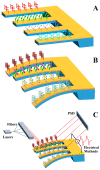
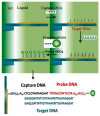








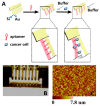

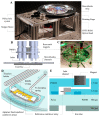
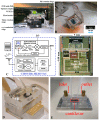
Similar articles
-
Optical Fiber Probe Microcantilever Sensor Based on Fabry-Perot Interferometer.Sensors (Basel). 2022 Aug 1;22(15):5748. doi: 10.3390/s22155748. Sensors (Basel). 2022. PMID: 35957304 Free PMC article. Review.
-
Computational Evaluation of Suspended Microcantilever and Microfluidic Channel.Annu Int Conf IEEE Eng Med Biol Soc. 2019 Jul;2019:1171-1174. doi: 10.1109/EMBC.2019.8856908. Annu Int Conf IEEE Eng Med Biol Soc. 2019. PMID: 31946102
-
Piezoresistive microcantilever-based DNA sensor for sensitive detection of pathogenic Vibrio cholerae O1 in food sample.Biosens Bioelectron. 2015 Jan 15;63:347-353. doi: 10.1016/j.bios.2014.07.068. Epub 2014 Aug 1. Biosens Bioelectron. 2015. PMID: 25113053
-
Rapid and Sensitive Detection of Severe Acute Respiratory Syndrome Coronavirus 2 in Label-Free Manner Using Micromechanical Sensors.Sensors (Basel). 2021 Jun 29;21(13):4439. doi: 10.3390/s21134439. Sensors (Basel). 2021. PMID: 34209484 Free PMC article.
-
Microcantilever-based platforms as biosensing tools.Analyst. 2010 May;135(5):827-36. doi: 10.1039/b908503n. Epub 2010 Jan 13. Analyst. 2010. PMID: 20419229 Review.
Cited by
-
Biosensors; nanomaterial-based methods in diagnosing of Mycobacterium tuberculosis.J Clin Tuberc Other Mycobact Dis. 2023 Dec 25;34:100412. doi: 10.1016/j.jctube.2023.100412. eCollection 2024 Feb. J Clin Tuberc Other Mycobact Dis. 2023. PMID: 38222862 Free PMC article. Review.
-
Numerical Analysis of Microfluidic Motors Actuated by Reconfigurable Induced-Charge Electro-Osmotic Whirling Flow.Micromachines (Basel). 2025 Jul 31;16(8):895. doi: 10.3390/mi16080895. Micromachines (Basel). 2025. PMID: 40872402 Free PMC article.
-
Investigating a Detection Method for Viruses and Pathogens Using a Dual-Microcantilever Sensor.Micromachines (Basel). 2024 Aug 31;15(9):1117. doi: 10.3390/mi15091117. Micromachines (Basel). 2024. PMID: 39337776 Free PMC article.
References
-
- Wilfinger R.J., Bardell P.H., Chhabra D.S. The Resonistor: A Frequency Selective Device Utilizing the Mechanical Resonance of a Silicon Substrate. IBM J. Res. Dev. 1968;12:113–118. doi: 10.1147/rd.121.0113. - DOI
-
- Heng T.M.S. Trimming of Microstrip Circuits Utilizing Microcantilever Air Gaps (Correspondence) IEEE Trans. Microw. Theory Tech. 1971;19:652–654. doi: 10.1109/TMTT.1971.1127595. - DOI
-
- Cleveland J.P., Manne S., Bocek D., Hansma P.K. A nondestructive method for determining the spring constant of cantilevers for scanning force microscopy. Rev. Sci. Instrum. 1993;64:403–405. doi: 10.1063/1.1144209. - DOI
-
- Mahmoud M.A. Validity and Accuracy of Resonance Shift Prediction Formulas for Microcantilevers: A Review and Comparative Study. Crit. Rev. Solid State Mater. Sci. 2016;41:386–429. doi: 10.1080/10408436.2016.1142858. - DOI
-
- Peng W., Wei Z., Hai W., Yan L., Qin H. Geometry and profile modification of microcantilevers for sensitivity enhancement in sensing applications. Sens. Mater. 2017;29:689–698.
Publication types
Grants and funding
LinkOut - more resources
Full Text Sources

